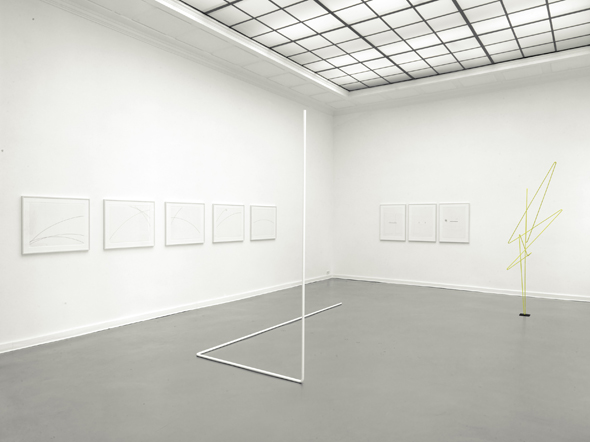20 September–30 November 2014
Aurel Scheibler
Schöneberger Ufer 71
10785 Berlin
Hours: Tuesday–Saturday 11am–6pm
“…When one looks at Kricke’s creations for a longer time and absorbs their rhythm, they calm down. In this restful midpoint is a great silence. And in this silence, something has been said—something about the life of human beings—their destiny—something about the universe…”
–John Anthony Thwaites, 1953
In his historic spaces at Schöneberger Ufer, Aurel Scheibler is showing an exhibition dedicated to the German sculptor and draftsman Norbert Kricke (1922–1984). This is the first time that the oeuvre of one of the most revolutionary and important post-war sculptors is presented in a solo exhibition in Berlin.
Norbert Kricke focuses on sculpture and drawing from the 1950s and 1970s and emphasizes the distinct relationship that exists between Kricke’s early and late work. The exhibition runs until Sunday 30 November.
Born in 1922 in Düsseldorf, Kricke was part of a generation of artists that had to find a new departure after the war. Depending on context, background and personal circumstances, artists reacted differently to their newly re-acquired liberty. In Kricke’s case, rather than trying to reconnect with the past, the artist was strongly influenced by Kandinsky, the Constructivist artists and Malevich. In the early ’50s, Kricke succeeded in breaking up the compactness and denseness, which had characterized so much of sculpture for so long. He found his way to sculptures that develop from the line alone and obtain spatiality as a result of multiple right-angled changes of direction. In these sculptures space is not something that is enclosed and bordered by a line; instead the line becomes the phenomenon that opens up space and denies it a precise determinability and measurability. From this time onwards, Kricke confronted a problem that would occupy his thinking almost exclusively: the examination of the phenomena of movement and space. Whereas Calder incorporated real movement in his mobiles, Kricke decided from the very beginning to visualize the inherent movement of space in his sculpture. Kricke formulated his artistic intentions in a way that would continue to apply in the following decades: “My problem is not mass, not figure, but it is space and it is movement—space and time. I do not want a real space or a real movement (mobiles); I want to represent movement. I am trying to give form to the unity of space and time.”
The drawings that Kricke produced formed an autonomous and important part of his artistic work. It was the drawing, the act of drawing, that connected him in the most profound and direct way to the element which constituted the alpha and omega of his working and thinking: the line. The line in Kricke’s work is a forceful, at times almost sensuous presence that suggests movement and space, dynamism and fullness. The source of his line, ultimately the source of all Kricke’s work, was the body, the body as an incarnation of the play of movement. It is the body that sets our coordinates for the experience of space and Kricke actively and consciously used this key human reference point for the creation of his sculpture as well as his drawings. In following the movement of the lines, one literally follows the artist’s hand and arm, as he swung over the sheet of paper to evoke energy, depth, vivacity, tension, methodically and rhythmically. There is no hierarchical relationship between the sculpture and the drawings. To Kricke they acted as sovereign parallels and were connected in manifold ways. Both are strongly reflective of his fascination with light and air. Both are primordially focused on making the heavy, light. And both offer an existential experience in which our “being in the world” takes place and thus, they ultimately offer a sense of freedom.
